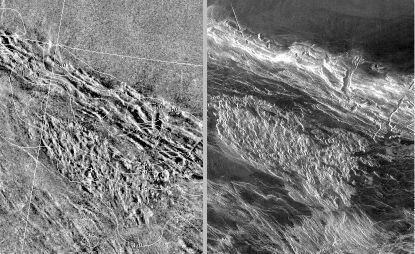SATCAT no. 14104 Inclination 92.5° Launch mass 5,250 kg Last contact 10 July 1984 | COSPAR ID 1983-053A Spacecraft type 4V-2 No. 860 Period 24 hours Launch date 2 June 1983 | |
 | ||
Operator Soviet Academy of Sciences Similar | ||
Venera 15 (Russian: Венера-15 meaning Venus 15) was a spacecraft sent to Venus by the Soviet Union. This unmanned orbiter was to map the surface of Venus using high resolution imaging systems. The spacecraft was identical to Venera 16 and based on modifications to the earlier Venera space probes.
Contents
Mission profile
Venera 15 was launched on June 2, 1983 at 02:38:39 UTC and reached Venus' orbit on October 10, 1983.
The spacecraft was inserted into Venus orbit a day apart from Venera 16, with its orbital plane shifted by an angle of approximately 4° relative to one another probe. This made it possible to reimage an area if necessary. The spacecraft was in a nearly polar orbit with a periapsis ~1000 km, at 62°N latitude, and apoapsis ~65000 km, with an inclination ~90°, the orbital period being ~24 hours.
Together with Venera 16, the spacecraft imaged the area from the north pole down to about 30°N latitude (i.e. approx. 25% of Venus surface) over the 8 months of mapping operations.
Spacecraft structure
The Venera 15 and 16 spacecraft were identical and were based on modifications to the orbiter portions of the Venera 9 and Venera 14 probes. Each spacecraft consisted of a 5 m long cylinder with a 0.6 m diameter, 1.4 m tall parabolic dish antenna for the synthetic aperture radar (SAR) at one end. A 1-meter diameter parabolic dish antenna for the radio altimeter was also located at this end. The electrical axis of the radio altimeter antenna was lined up with the axis of the cylinder. The electrical axis of the SAR deviated from the spacecraft axis by 10 degrees. During imaging, the radio altimeter would be lined up with the center of the planet (local vertical) and the SAR would be looking off to the side at 10 degrees. A bulge at the opposite end of the cylinder held fuel tanks and propulsion units. Two square solar arrays extended like wings from the sides of the cylinder. A 2.6 m radio dish antenna for communications was also attached to the side of the cylinder. The spacecraft each massed 4000 kg.
Both Venera 15 and 16 were equipped with a Synthetic Aperture Radar (SAR). A radar was necessary in this mission because nothing else would be able to penetrate the dense clouds of Venus. The probes were equipped with on board computers that saved the images until the entire image was complete. This radar system replaced the normal landers that previous Venera probes brought to Venus.
List of spacecraft instruments and experiments:
